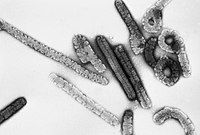
Photo from wikipedia
Marburg virus (MARV) is a highly pathogenic virus associated with severe disease and mortality rates as high as 90%. Outbreaks of MARV are sporadic, deadly, and often characterized by a… Click to show full abstract
Marburg virus (MARV) is a highly pathogenic virus associated with severe disease and mortality rates as high as 90%. Outbreaks of MARV are sporadic, deadly, and often characterized by a lack of resources and facilities to diagnose and treat patients. There are currently no approved vaccines or treatments, and the chaotic and infrequent nature of outbreaks, among other factors, makes testing new countermeasures during outbreaks ethically and logistically challenging. Without field efficacy studies, researchers must rely on animal models of MARV infection to assess the efficacy of vaccines and treatments, with the limitations being the accuracy of the animal model in recapitulating human pathogenesis. This review will compare various animal models to the available descriptions of human pathogenesis and aims to evaluate their effectiveness in modeling important aspects of Marburg virus disease.
Journal Title: Virology Journal
Year Published: 2019
Link to full text (if available)
Share on Social Media: Sign Up to like & get
recommendations!